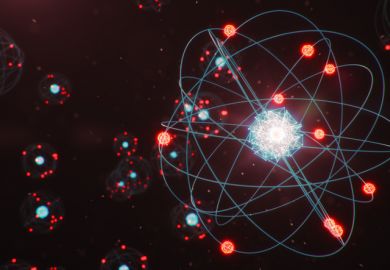Quantum Electro-Dynamics (QED) is the brightest jewel in fundamental particle theory today. The system (electrons, positrons and photons) is almost separate from other particles, at least when the energies are not too high. Calculations of electromagnetic processes have been made with a high degree of accuracy, especially by Toshio Kino****a, in powers of a/9, where a is the dimensionless coupling parameter = approximately 1/137. The electron magnetic moment, (1 + ae) Bohr magnetons, has been measured to an accuracy q4x10-12, the calculated value of ae being 115,965,214q1x10-12, a remarkable degree of agreement. Yet significant improvements in both theory and experiment are now under way.
Silvan Schweber's book traces out all of the threads leading to this success story. There are two central characters, Julian Schwinger and Richard Feynman, very different in background, nature and style, and Freeman Dyson, the man who managed to relate their methods and theories, within conventional Quantum Field Theory (QFT). All three were precocious and given elitist educations, and it is made clear how important this education among gifted contemporaries was for their development as physicists. Even more important were the unconventional professors who took note of their abilities, treated them as equals and made opportunities for them to progress more quickly.
It is also clear from this book how important for them was the early work of Dirac, a man in the generation of physicists above them. Besides his discovery of the relativistic wave equation for the electron, he invented QFT. In the extensive bibliography of Schweber's book, Dirac's name appears more than three times more often than any other citation. Yet, in the end, Dirac was not with them. He rejected their renormalisation programme as unsound mathematics and would not regard their results as valid physics, no matter how remarkable the comparisons of their calculations with the data.
Feynman was from Far Rockaway, on Long Island. His tertiary education was at MIT, an institution noted for quality, and special arrangements were made for Ted Welton and him to learn quantum mechanics, and even to do a little research with it, while still undergraduates. At Princeton University he was fortunate to have John Wheeler as his adviser, for Wheeler encouraged him, expanding his mind and imagination. Wheeler's remark one day that "perhaps the reason why all electrons have the same charge is because they are all the same electron" shocked Feynman, but it probably later underlay Feynman's view of the positron as an electron going backwards in time - for Wheeler's jocular remark did contain a grain of truth important for Feynman's later development of his spacetime view of QED.
Wheeler and Feynman developed a classical theory of electromagnetic interaction between charged particles, jokingly referred to as the "Feeler-Feynman" theory since it involved action-at-a-distance, a formalism remaining after all of the degrees of freedom in the electromagnetic field had been integrated out. But how to quantise a theory where the interactions were non-local and there was no Hamiltonian? - that was Feynman's thesis problem. At this point, early in 1942, he ran into Herbert Jehle, a recently arrived refugee, who told him that Dirac had published a paper about using a Lagrangian instead, in a little known Russian journal in 1933; they went to the library together and Feynman realised at once that this was just what he needed. This was perhaps the greatest contribution Jehle made to the development of physics, since Feynman used this as the basic element in his new treatment of QED, where he developed a diagrammatic method for the calculations. It was easy to comprehend, and was relativistically invariant in form. Schwinger once referred to it as "bringing QFT to the masses", among whom I was happy to include myself. Other physicists were baffled by his presentations, unlike anything they knew before, and their reaction to Feynman's work was negative. Yet Feynman showed himself able to recalculate easily in several hours quantities that had taken conventional physicists many months to calculate.
Schwinger was another New Yorker with an unusual background. Early on he was found to read the physics journals regularly and to be able to contribute positively to discussions between his professors about current physics. Isidor Rabi of Columbia University broke all the rules to bring Schwinger to do graduate work at Columbia. Schwinger, a shy individual, took a course in oratory, from which he gained his remarkably effective didactic lecturing style. As time passed, he took more and more to working through the night, possibly as a means of avoiding the subtle pressures from more senior physicists who were about during the day. My teacher at Melbourne University, Bert Corben, worked with Schwinger at Berkeley in 1941, and told us that he had to adapt to Schwinger's night schedule to be able to carry on their collaborative work. When the Pacific war broke out, Schwinger began work with a radiation laboratory at Purdue University on problems involving electromagnetic radiation and its practical applications to radar. When the atomic bomb project was set up in 1943, taking many physicists, Schwinger elected to move with the Rad.Lab. to MIT. This work gave him extensive experience of Green's functions, his mainstay in the later work he used to refer to as "sourcery".
After the summer of 1945, the physicists moved back to their universities and looked afresh at the problems of fundamental physics. They were greatly helped in this by three National Academy of Sciences conferences, Shelter Island in 1947, Pocono Manor in 1948 and Oldstone in 1949. At Shelter Island, they learned of the Lamb shift, a separation between two levels of the hydrogen atom for which the Dirac equation predicted degeneracy, and of a small deviation of the electron magnetic moment from the Dirac value, both attributed to higher-order QED effects. Hans Bethe showed immediately that the bulk of the Lamb shift could be well estimated from non-relativistic effects; the main problem was to calculate the relativistic effects. A number of physicists worked on this problem, Schwinger, Feynman, Willis Lamb (with Norman Kroll) and Victor Weisskopf (with Bruce French). These last were the first to obtain the correct result, but they disagreed with Schwinger and with Feynman, who disagreed with each other, and so decided not publish their result, until they had checked it carefully again. By this time, Schwinger and Feynman had come to agreement and had each published this value. The news of the Lamb shift and Bethe's calculation of it had reached distant parts. In Japan, this stimulated Sin-Itiro Tomonaga and his students to carry out a relativistic calculation, since Tomonaga had developed a covariant form of QFT which could be adapted for this purpose, using a subtraction method to cancel out the infinities and achieving their result in September 1948, late but independently.
However, at Pocono Manor in 1948, the situation was bizarre. Schwinger had developed an immensely complicated formalism, relativistic but very difficult to follow, and probably not capable of extension to higher orders, even by Schwinger. Feynman had an entirely new procedure which could readily be applied to higher orders, but which involved ideas unfamiliar and unintelligible to all the experts. At this point Freeman Dyson came on to the scene. An Englishman, he had come to Cornell University in 1947 as a graduate mathematician of high calibre, aiming to become a theoretical physicist by working as a student of Bethe, certainly the best choice he could have made. Dyson was also fortunate that Feynman was then a young faculty member at Cornell, so that he quickly became familiar with Feynman's viewpoint and methods. He attended the 1948 summer school at Ann Arbor, University of Michigan, where Schwinger presented his methods and calculations. Everyday Dyson had discussions with Schwinger to clarify his lectures, but things were far from clear when the school ended. Dyson then had to go on a long journey across the United States and back; during this journey the pieces all fell into place in his mind and at Oldstone in 1949 he was able to demonstrate the relationship between the two theoretical methods.
This achievement had been his first aim; the second was to show that the renormalisation could be carried out consistently in all orders in a. Dyson did not really go beyond his published account of the a2 terms and his speculations about how the highest orders would go. As students in Rudolf Peierls's mathematical physics department in Birmingham University, where Dyson spent the year 1949-50, we interpreted his paper as implying that Dyson had solved all the problems about renormalisation. None of us thought to question this and he did not mention the subject, for his interest had then moved elsewhere. As Schweber states, although not very clearly, the demonstration that renormalisation was achieved in the way Dyson had speculated was not complete until more than a decade later. Many have felt, with good reason, that Dyson should have been awarded the Nobel prize for 1965, jointly with Schwinger and Feynman, but the number of persons sharing the prize is not permitted to exceed three, and the reasons for the choice made are clear. Weisskopf has expressed his feeling that he deserved some credit also. At least, both Dyson and Weisskopf shared the Wolf Prize for 1981 with 't Hooft.
Silvan Schweber has written a very deep and illuminating book, tracing the development of QED and also of the many physicists involved. He has gone back to all possible sources, to many unpublished records, including interviews (not always his) with many people no longer with us today. He has set out well the scene of the war years and their effects on these physicists and their subsequent work. His psychological study of Schwinger is fascinating; Schwinger's style led him to increasing isolation from outside influences on his physics and from students, who came to be attracted to other problems than those best known by Schwinger. Yet we know that Schwinger's abilities as a lecturer were, at the end, as impressive as they ever were, from hearing his long lecture on Green's functions at Nottingham University last year, in connection with the memorialisation of Green at Westminster Abbey. Schweber is also to be complimented on including a section on the work of Ernst Stuckelberg, a man who was many years ahead of his time, with many torments but having many insights not dissimilar to those of Feynman.
R. H. Dalitz is an emeritus professor of theoretical physics, University of Oxford.
QED and the Men Who Made It:: Dyson, Feynman, Schwinger and Tomonaga
Author - Silvan S. Schweber
ISBN - 0 691 033 7 and 03685 3
Publisher - Princeton University Press
Price - £65.00 and £29.95
Pages - 732pp



